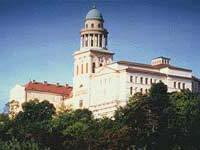|
Tewkesbury in
Gloucestershire
|
 Tewkesbury lies at the intersection of four main roads, which bisect four major cities, making it not only easily accessible but also a great place to catch a bus to any of its neighboring cities. Despite the constant flow of people in and out of this historic town, it still barely looks as if it has taken a step out of the twelfth century. Its exquisite Georgian house, handsome abbey, and the dainty line of teashops down the main street accentuate the medieval flavor of this town. Its location between two rivers helped to attribute to the fact that the seemingly untouched town escaped the Industrial Revolution. Yet, that mechanical revolution may have been one of the only ones not to leave its mark on this town. Everything from a ransacking by the Danes in the 9th century, which almost leveled the town, to being the site of the battle that would decide the English ruler to be Edward IV in the Civil War on May 1471 has taken place here.
Today Tewkesbury stands as a historical and also a religious center. It is home to over 200 historically noted and persevered buildings thanks to being named a Conservation area in 1967. A list of these places is available in various locations around town. Because of its name as the second most prestigious religious center, second to only Westminster, there is an exceptional number churches. The most famous of all these places is Tewkesbury’s Benedictine Abbey. The abbey includes fifteen bell towers, twelve of which contain six bells, one having thirteen bells, and the other holding three bells. Even more impressive is the abbey’s Norman central tower soaring 132 feet high and extending 46 feet in width making it the largest of its kind in the world. The six stunning exterior recessed arches reach 65 feet in height, which is extremely impressive for that type of structure. While structurally the abbey is breath taking, its contents are also striking. It holds the most medieval tombs in Britain with a few important historical figures. Edward of Lancaster, the Fitzhamons, the De Clares, the Despensers, the Beauchamps Abbot Alan, and George, the Duke of Clarence all rest within its tombs. There are also over three magnificent organs and marvelous statues each with a different history inside this building. There aren’t enough words to do this abbey justice, it’s simply better seen and heard.
Tewkesbury lies at the intersection of four main roads, which bisect four major cities, making it not only easily accessible but also a great place to catch a bus to any of its neighboring cities. Despite the constant flow of people in and out of this historic town, it still barely looks as if it has taken a step out of the twelfth century. Its exquisite Georgian house, handsome abbey, and the dainty line of teashops down the main street accentuate the medieval flavor of this town. Its location between two rivers helped to attribute to the fact that the seemingly untouched town escaped the Industrial Revolution. Yet, that mechanical revolution may have been one of the only ones not to leave its mark on this town. Everything from a ransacking by the Danes in the 9th century, which almost leveled the town, to being the site of the battle that would decide the English ruler to be Edward IV in the Civil War on May 1471 has taken place here.
Today Tewkesbury stands as a historical and also a religious center. It is home to over 200 historically noted and persevered buildings thanks to being named a Conservation area in 1967. A list of these places is available in various locations around town. Because of its name as the second most prestigious religious center, second to only Westminster, there is an exceptional number churches. The most famous of all these places is Tewkesbury’s Benedictine Abbey. The abbey includes fifteen bell towers, twelve of which contain six bells, one having thirteen bells, and the other holding three bells. Even more impressive is the abbey’s Norman central tower soaring 132 feet high and extending 46 feet in width making it the largest of its kind in the world. The six stunning exterior recessed arches reach 65 feet in height, which is extremely impressive for that type of structure. While structurally the abbey is breath taking, its contents are also striking. It holds the most medieval tombs in Britain with a few important historical figures. Edward of Lancaster, the Fitzhamons, the De Clares, the Despensers, the Beauchamps Abbot Alan, and George, the Duke of Clarence all rest within its tombs. There are also over three magnificent organs and marvelous statues each with a different history inside this building. There aren’t enough words to do this abbey justice, it’s simply better seen and heard.
|
|